8 Fundamentals to Master as a Developing Artist
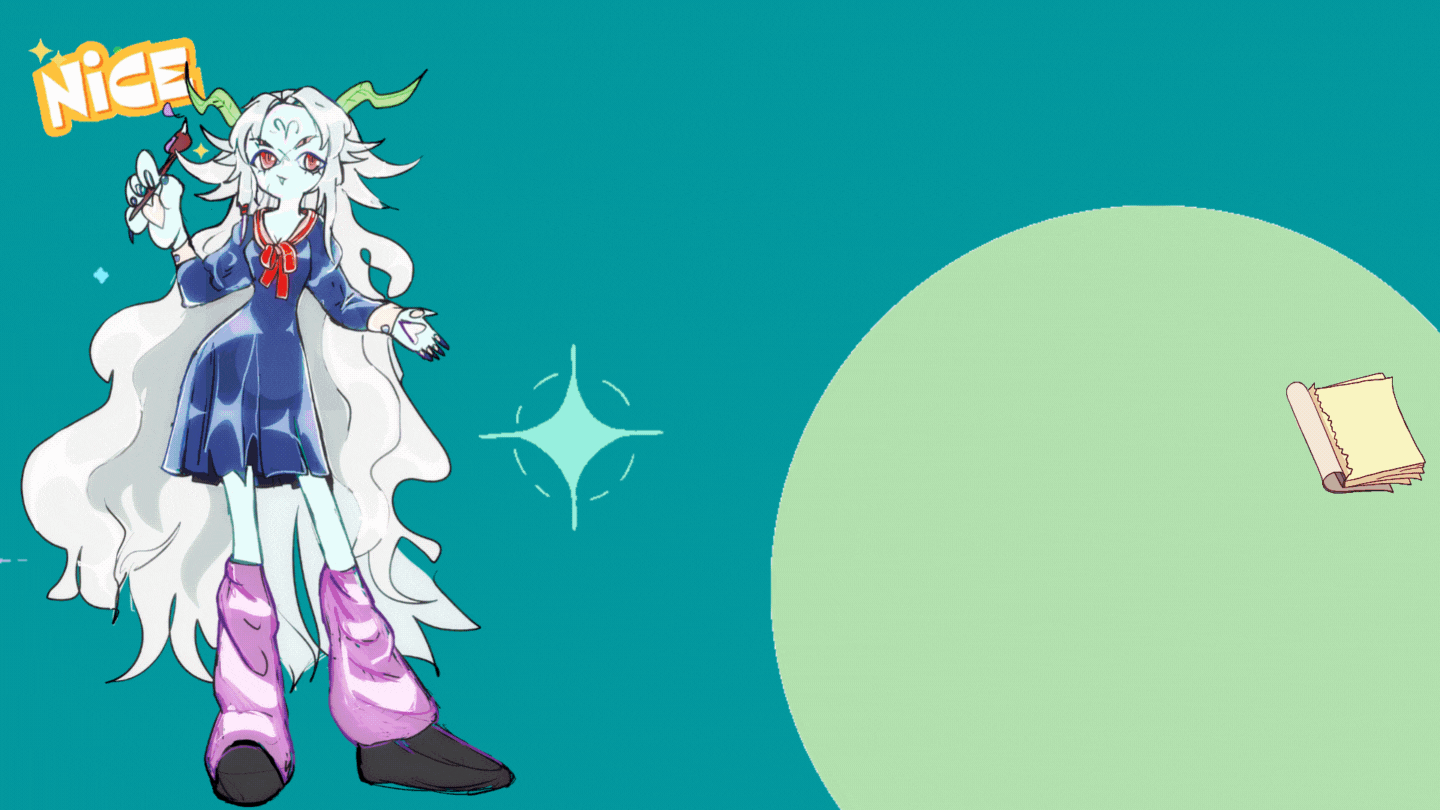
Why are fundamentals important? How can mastering them help me grow as an artist?
Focusing on the fundamentals means making sure to learn the building blocks of different art concepts and techniques in order to grow your skills over time. This is the same advice you may have heard a million times, but in a way it applies to everyone no matter where they are in their artistic journey. There are many things considered as fundamental to learning art, and you can pick and choose which ones will help you most on your journey. These are 8 fundamentals you can learn to master that will help you develop as an artist.
Imagine looking at the world around you and being able to translate the details of what you see into art on a page. The shapes, lines and colors that make up the solitary oak tree you saw on your morning walk could become the detailed background art for your latest comics. You can apply your knowledge gained through studies and observations from everyday life to your works and broaden your skills and artistic horizons. When you learn to master the fundamentals you can become a more versatile and well-rounded artist.
This process can be accomplished no matter your skill level or budget. Utilizing free resources and connecting with your peers for more information can allow you to master the fundamentals, too!
If you want to learn alongside other artists, consider joining the UnVale Discord.
1. Shapes
What key shapes make up the objects in life, and how do we identify them? Can mastering shapes really improve my skills as an artist?
The idea of shape sounds a bit confusing at first, but just like when you want to paint a big picture, you have to break it down into approachable steps. Shapes are found in all things. Biomorphic shapes in things like nature exist as well as geometric shapes found in things like architecture or machinery.
This YouTube video from the team over at Winged Canvas breaks down the concept of shape in 7 minutes and explains how learning about shape is one of the building blocks of getting into art. It talks about starting out with basic geometric shapes and learning how to incorporate them into more complicated shapes and designs as you get more comfortable.
This is a great way to think about shape, and sets you up to take this knowledge with you moving forward. Feel free to check out their website for more helpful tutorials.
Some more resources for mastering shape can be found in this FREE guide from the EtheringtonBros with nearly 300 tips on how to think about drawing. This tweet below shows a snippet from their guide which discusses body shapes and how you can use them to support your design vision for creating characters.
BODY SHAPES Pt 1 from the #howtoTHINKwhenyouDRAW encyclopedia - the world’s ONLY encyclopedia of drawing tutorials, posted up FREE for EVERYONE, FOREVER, with NEW and CLASSIC tutorials coming up EVERY DAY right here only on our twitter :)#gamedev #manga #conceptart #illustration pic.twitter.com/30z8onGtop
— EtheringtonBrothers (@EtheringtonBros) August 19, 2022
And there's also a host of independent artists out there creating personalized tutorials explaining how they use shape to achieve their works. This lovely reference sheet by hyanna-natsu is a great example explaining different ways they approach drawing hair. The artist uses their understanding of shapes to create different hairstyles. Each hairstyle has a different feeling and process used to achieve it.
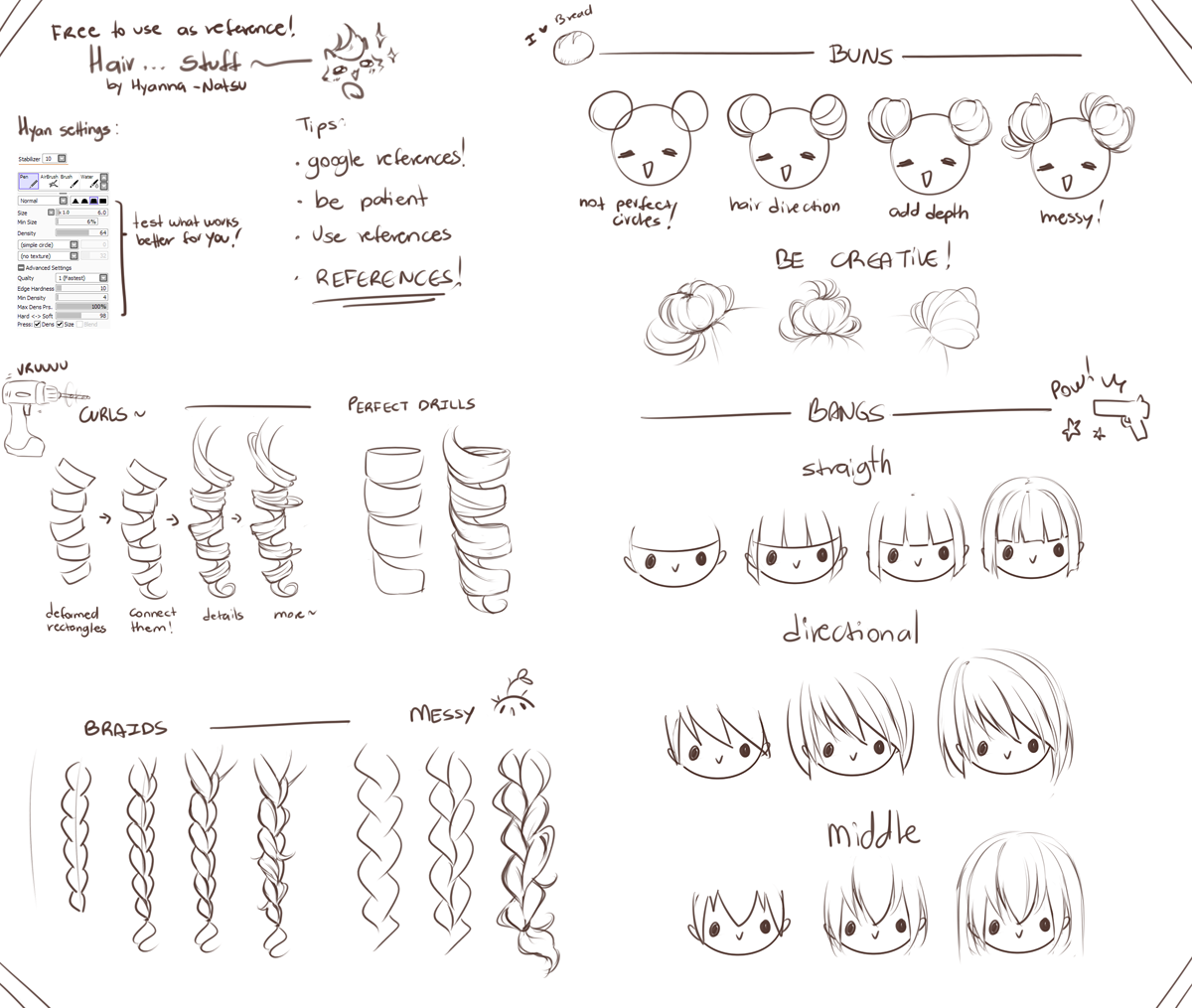
The artist reinforces that being patient and using references is vital to the process. You can look at a reference for the shapes found in a bun hairstyle and see what the artist shows here, that the basic shapes are two circles atop the characters' head. Adding detailed lines gives depth to the hair and overall character as the shapes change.
We can apply our knowledge of shape to realistic illustrations as well as stylized ones. Breaking things down into shapes can help you create hairstyles, horses, sidewalks, and anything else you can imagine while you learn to master the skill.
2. Anatomy
What is anatomy? Why is it important? How is anatomy used in art?
"Anatomy in art is important for the correct representation of human figures. Artists, therefore, study the structure and range of motion of the human body. The same goes for depicting animals." - Why is Anatomy Important in Art, Deborah
Anatomical knowledge allows you to more realistically depict humans and animals in your artwork. Understanding the logic behind the movement of the human body, as well as the forms that make it up, will allow you to advance in your work. Along with realistic art, this knowledge can then be applied to artforms such as animation, comics, film making, 3D modeling, and more.
If you're looking for a resource for improving your anatomy skills, check out this amazing photo by the artists at CGCCookie! They host all sorts of helpful tutorials for anatomy that can help you improve your skills in concept design, sculpting, illustration, and so much more. This photo highlights how using knowledge of both shape, as seen in step 4, and anatomy, as see in steps 1-3, simplifies the process of drawing knees.
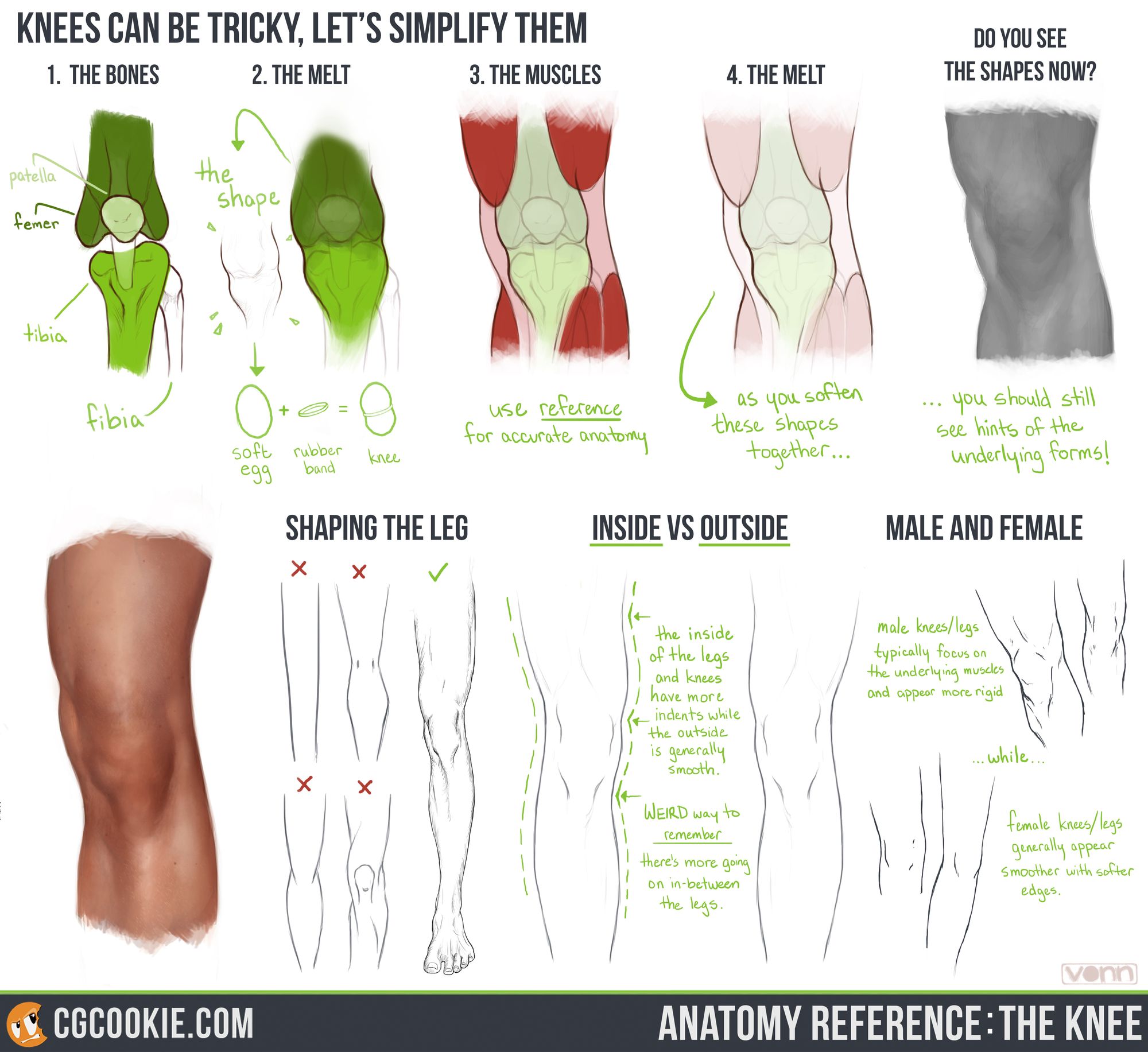
You can also find helpful resources from your favorite artists collected in books and online boards, like this set below from Jack Hamm posted on reddit by u/DeDePlane.
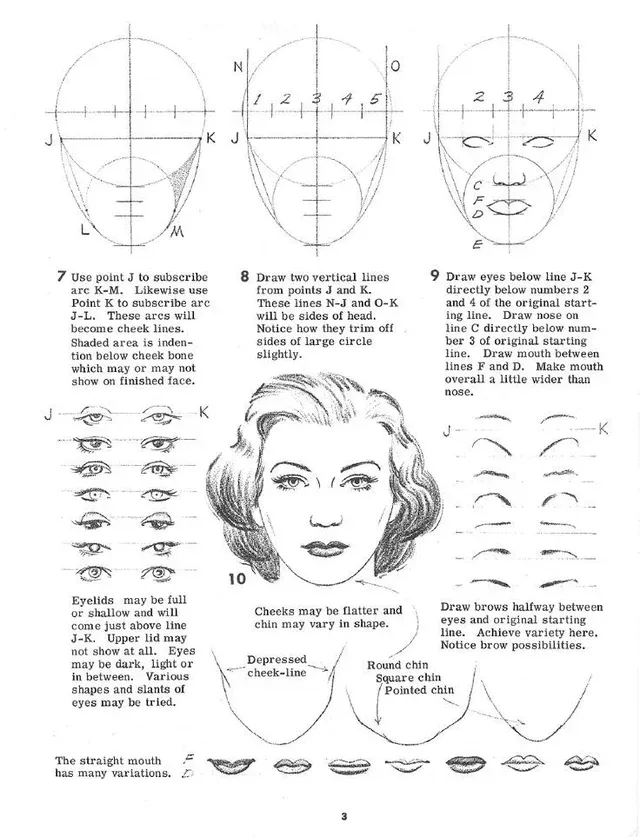

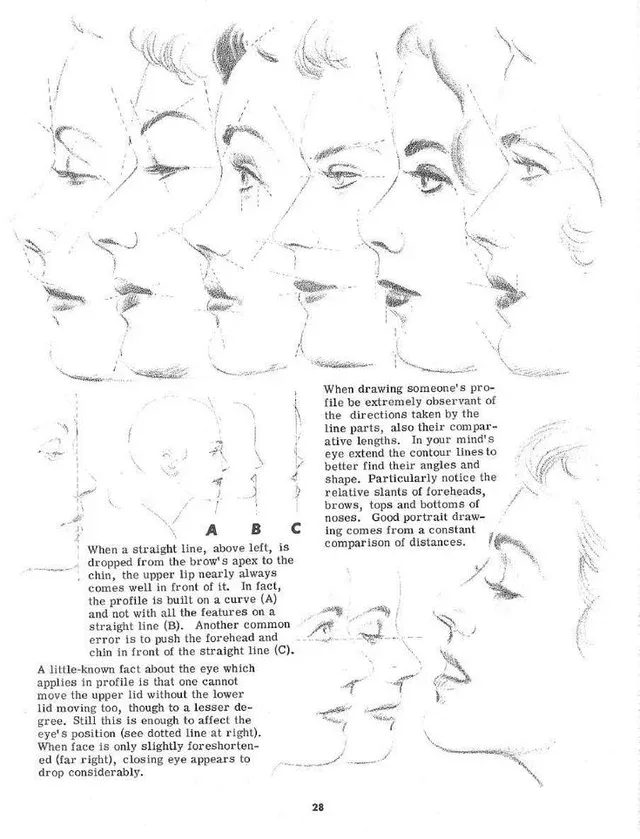
Though this proportions may not apply to everyone and this uses gendered language, this is still an extremely valuable resource on how to identify traits on a face and provides logic and reasoning on how these parts on the face work and move.
And this lovely tutorial below from neonz_art shows how this type of thinking can also be applied to drawing animals!
✨ Tutorial ✨How to Draw Snoots! If you wish to see the full tutorial and pick future ones, consider becoming a patreon! https://t.co/XZ2B2pynm8#tutorial #Procreate #stepbystep #Patreon #cats #art #CatsOfTwitter #digitalart #howtodraw #feline pic.twitter.com/zNhNJHHnOl
— neonz_art ✨comms.: 1/3 (@neonz_art) August 14, 2022
3. Perspective
What is perspective? Can mastering perspective allow me to further develop as an artist? Perspective determines so much about the composition and feel of an image.
This video from Art of Wei is a great introduction into perspective drawing.
Once you have a more nuanced understanding of perspective, you can then begin to see how this knowledge can be used in tandem with other fundamental skills. You can do simple practices, like drawing a head from many different angles, or creating a cityscape from boxes.
In the following tutorial, the artist Robert Marzullo shows how using a mixture of anatomic studies and perspective guidelines can help you in drawing one of the most notoriously hard-to-draw objects: Hands.

Robert goes even further in depth on this topic on their blog, with a full tutorial on how to draw hands, including tips and techniques. Here they break down how to study the anatomy of the hand, and understand the logic of how it moves. Then, this knowledge is used when translating the hands into different viewpoints. When you move your hand closer to the face, it looks completely different then when you look at it from the side or farther away! You can try experimenting drawing hands in different angles and think about what those shapes would look like.
If you need some more help figuring out how to practice perspective, the artist ccRask has created this awesome worksheet for their online class and posted it online for free.

This worksheet is a quick exercise in 1 and 2 point perspective, and filling it out will give you an easy reference on hand to always come back to! Make sure to check out some of their other tutorials as well, such as the one about...
4. Values
Values are another fundamental aspect of art. Working with values gives the artist a deeper understanding of light and shadow. Values help you improve at both black and white work, and give more depth to your color illustrations. You can create realistic renders, defined shapes, detailed backgrounds, stunning faces, and so much more by mastering values.
A fantastic resource to help you start your journey is posted below, created by the artist Tim Von Rueden at CGCookie . They have created a wonderful and helpful exercise sheet on values. This sheet is so amazing at showing how much depth and texture can be added to an object over time with an understanding of values. Showcasing their step-by-step process exploring the basics of shading, Tim also provides a detailed explanation which is quoted in the toggle box below.
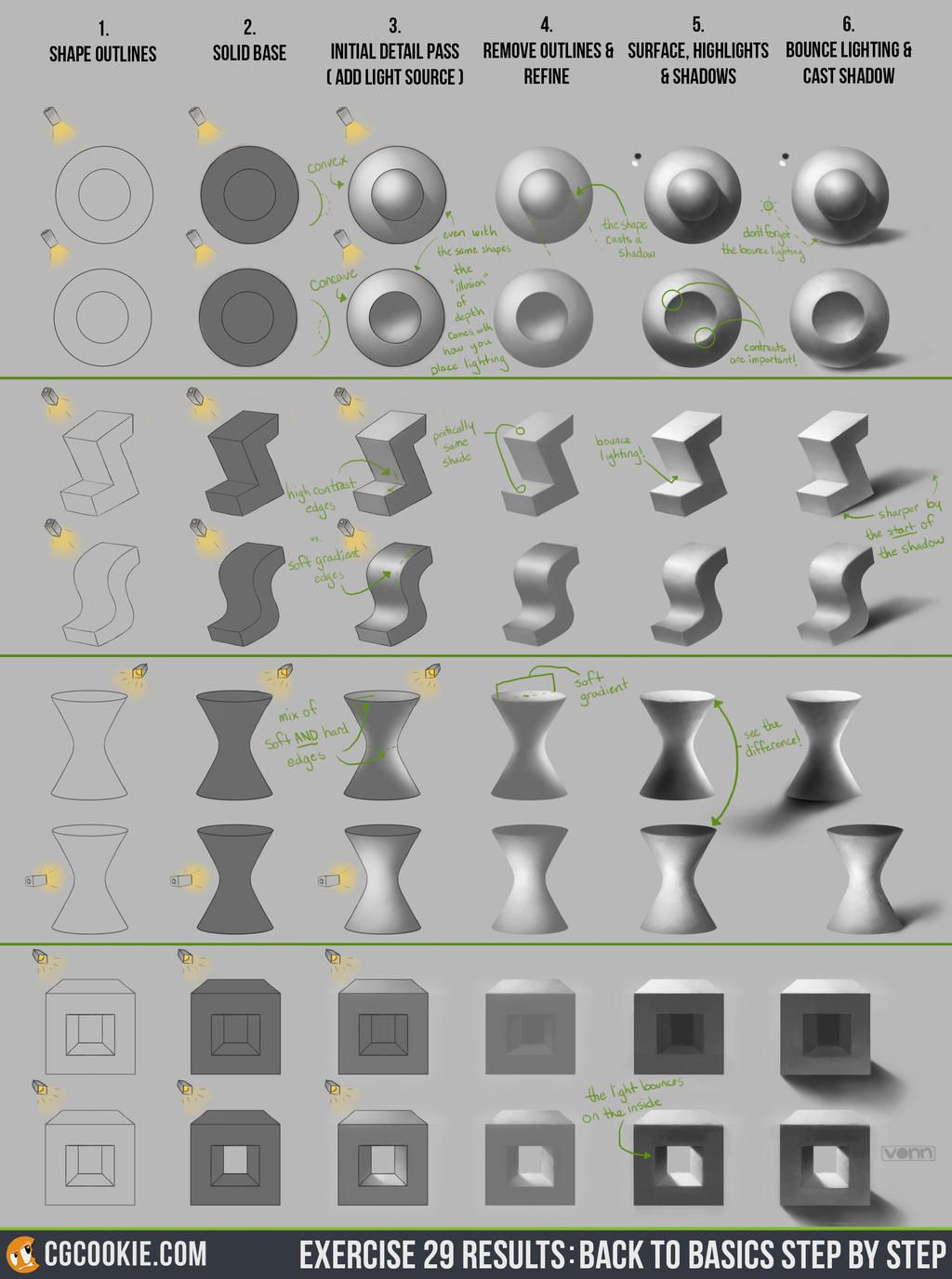
"EXERCISE: Taking a look at refining the basics of adding values doing simple exercises" by CGCookie
"Below is a step by step on how I created each of the value studies from the exercise practice sheet. I broke it down into each significant step on what was included or added:
- Outline - Begin with the overall shaping of the object you are going to shade.
- Solid Base - Try working with a darker base color to act as your foundation for you to work on top of.
- Initial Detail Pass - Before laying down another color, focus on where you want your light source and stay consistent throughout! Really look at if the surface is curved or flat: That makes a HUGE difference.
- Remove Outlines and Refine - This will give the gem a solid foundation from here to detail further! Subtle gradients will add that extra touch of realism.
- Surface, Highlights, and Shadows – This is the hardest step. Really focus on the lighting on how it interacts with each object.
- Bounce Lighting and Cast Shadow - For the final polish pass work on the environment around your object so in this case bounce lighting would be received on the bottom side of the object as well as casting a shadow on the ground beside it based on where the lighting is coming from."
"Exercise 29: Back To Basics Step By Step By Cgcookie On Deviantart". Deviantart.Com, 2022, https://www.deviantart.com/cgcookie/art/Exercise-29-Back-to-Basics-Step-by-Step-482527864.
Deep diving into exercises like that one above will reinforce what you learn as you continue seeking out tutorials and developing your shading skills. Feel free to follow along with Tim, and if you do, reach out to them to let you know how much it helped you!
As you continue learning about values, you'll want to experiment with different tools and techniques to gain a deeper understanding. This tutorial from Mark Crilley is a great example of 3 different ways you can use pencil shading techniques to experiment with values. He breaks things down in a way that is easy to understand and replicate.
Mark's channel has so many amazing video resources, including a few more videos on shading techniques for different art styles. It is definitely worth checking out! Watching his videos are how a lot of artists first got into drawing, and you'll pick up terms and tips that will stick with you through your journey mastering the fundamentals.
And finally, to continue practicing what you've learned so far on values and combine it with other fundamental skills, here is another worksheet from the amazing ccRask, but this time focusing on shading with values! This exercise is a very simple resource you can reference to explain what values are and the first steps of shading.
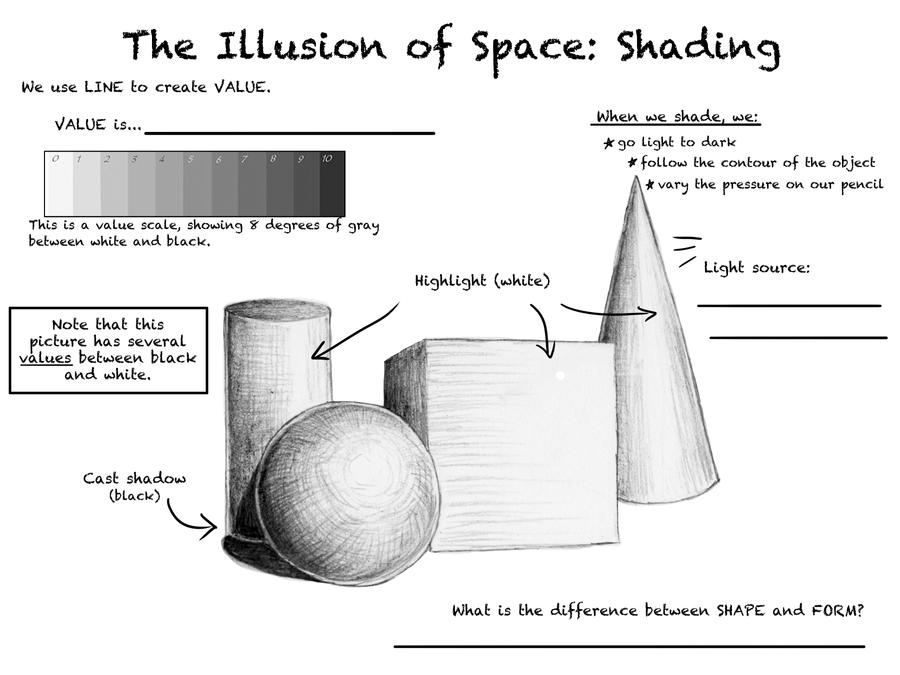
In their notes, ccRask writes the answers to each question for easy referencing. Shape and form are elements that go hand in hand with learning values, and you can see how using them in combination with the value scale provided allows you to create dynamic and interesting illustrations.
5. Color
How can understanding color help me develop as an artist? What all is there to learn?
There is a plethora of knowledge to learn on color, so this will definitely be a topic that gets revisited. A fundamental skill, how an artist chooses to use color has so much nuance and meaning. Some artists use bold, bright and vivid neon colors to send a message, while others use darker tones or full black and white, while still others use unique mixtures of different palettes to create shocking effects!
Since the concept of color has so much depth by nature and it can be quite overwhelming at times, it's important to remember that you don't have to learn it all at once. You can apply knowledge that you pick up from multiple sources as you progress in your career!
It all starts with the color wheel.

The website usability.gov breaks down the concept of color, going in depth on the different different categories of use for artists. The way people interpret color is a fascinating area of study and will greatly aid you in deciding colors in your work. The site mentions the Color Wheel, Neutrals, Color Models (CMYK vs. RGB), and even touches briefly on the importance of hex-codes. This makes this resource valuable for traditional artists as well as digital ones, as you can use hexcodes to easily create color palettes based on your work or apply these color concepts to traditional paintings.
Once you start to understand the basics of color, the next part of mastering color is learning more about color theory. This is a masterpost with a whole list breaking down color theory and showing examples of further learning.
Below is an example from one of the linked tutorials, Basic Color Theory from designmatters.com, where the author explains the difference between analogous and complementary colors.

These examples are some basic formulas that result in color harmony, and the article goes on to discuss some more principles of color, like evaluating color in context of other colors.
Mastering color will take time, but having that the knowledge of that tool at your disposal will allow you to create masterful, vivid works full of color!
6. Composition
Composition refers to what objects and aspects an image consists of, and how an artist chooses to place them. This is an element of art that many struggle with, but gaining a mastery of it can allow you to take your works to new heights. You can create dramatically different feelings in a painting, for example, depending on how you approach the composition.
This video from Mark Crilley provides a thorough breakdown of composition that is easy to follow along with as Mark walks us through some common composition options and their explanations. Through the use of simple paper and pencil images, mark is able to make this concept very approachable.
He also mentions some pencil practices you can do to play with these concepts. His pencil cutouts are very similar to using layers on a digital paint program, and so this tutorial can easily be used by digital artists as well as traditional!
To continue your learning, you can check out further videos like this one from Jazza where he explains some more composition ideas in depth as he illustrates some examples in multiple frames.
Jazza mentions using elements of different fundamentals, such as perspective, in his compositions to create works that better show his ideas. Thinking about layout and composition can allow you to better highlight the focal point of your image, and also create a sense of balance and harmony (or lack thereof).
This video does an amazing job of breaking down the different elements of a picture, including the background, midground, foreground, and horizon and how you can use them to complement each other. Focal points and contrast also start to play a big part in composition, and Jazza breaks this down wonderfully. They also have a series talking about some other fundamentals that they encourage us to follow along with here.
These videos should give you a foundation for understanding and exploring different compositions in your work.
7. Brushwork
Brushwork is something that both digital and traditional artists can master, and although the techniques for each may be a bit different they can both learn from the same core concepts! Mastering brush techniques allows you to creature special textures in your art, and also save a ton of time in creating certain elements of your illustrations.
To start with, one of the masters of teaching brush work is a guy that everyone knows and loves: the one and only Bob Ross.
Following along with his famous series "The Joy of Painting" will teach you so much about the fundamentals of art, especially brushwork and how he uses those brush techniques to create depth with ease.
Full seasons of the show can be watched for FREE on YouTube, like this episode where he paints a Cactus at Sunset:
So much of Bob's technique involves his fluid use of brushwork. Right away in this video, he uses a fan brush with bright yellow and crimson tones and specific movements to create the illusion of light coming from the Sun.
Bob lists out his materials so that you can follow along with ease, and he fans and blots with his hands in a way that you can replicate with brushes in real life. He uses a palette knife to scrape parts away, and uses his brush techniques in combination with his knowledge of values to make the image come alive.
The cool thing is, as well as following along with traditional mediums in real life, you could take the techniques he's teaching and apply it in digital paint programs to make your art. Using a paint program like Clip Studio or Procreate, you could find (or create) a fan-shaped brush and paint a sunset in a similar fashion.
Creating and downloading custom brushes and knowing how to use them are actually a vital aspect of mastering the fundamentals of brushwork for digital artists!
One of the most helpful and popular brushsets we've seen online is this one from Devin Elle Kurtz.
🌃Cityscape Brushset for Photoshop, Procreate, and Clip Studio Paint 🌃
— Devin Elle Kurtz (@DevinElleKurtz) March 4, 2021
-114 responsive brushes + multiple demo videos
-Free with optional donation
-Royalty-free for all personal and commercial work
Download link threaded below! pic.twitter.com/u3zGqEJB6t
This brushset is available for download with suggested donation, and can allow you to create beautiful cityscapes with ease!
Take this picture we commissioned from the artist Kravuus, featuring the character Niall from UnVale.
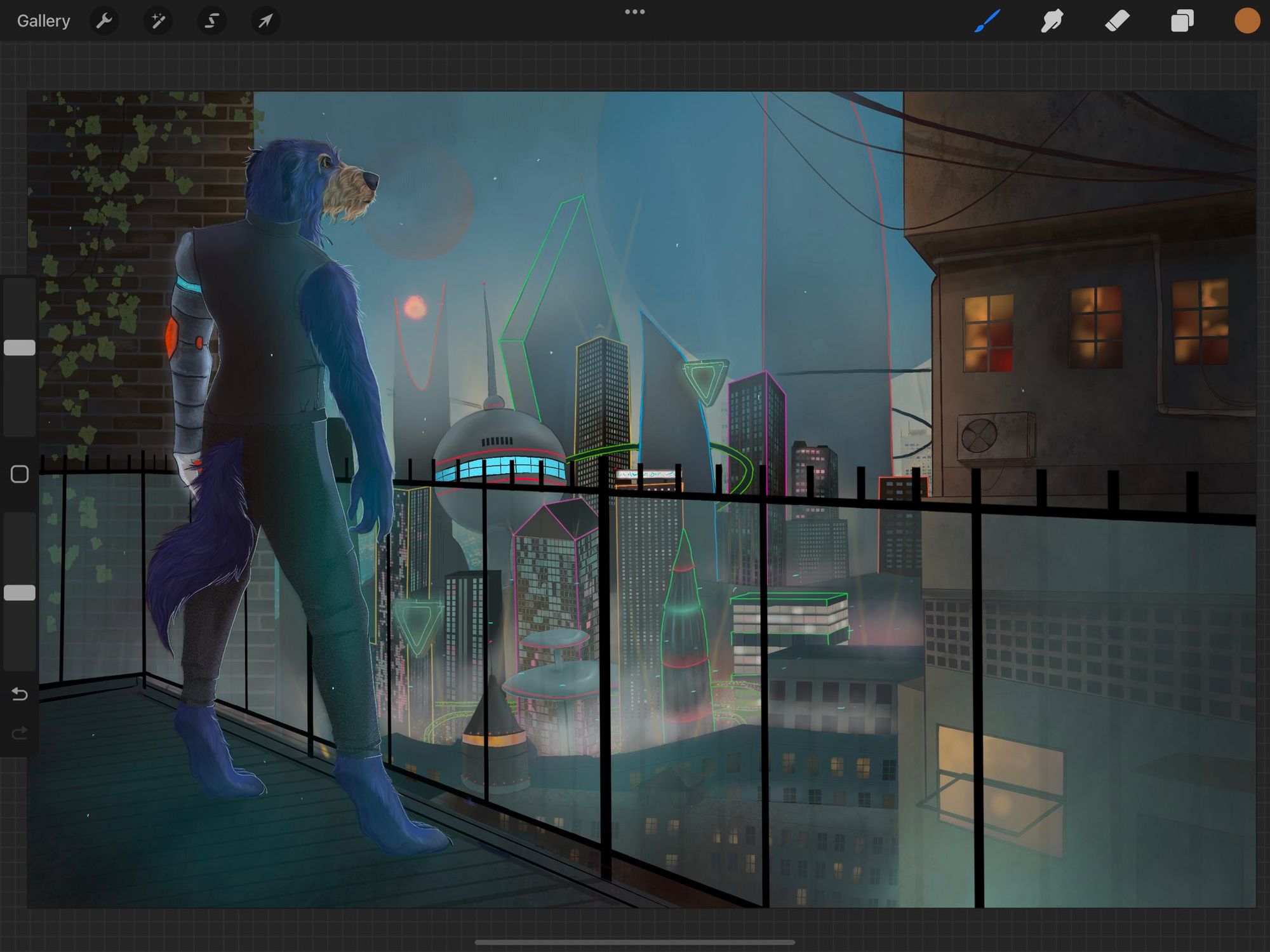
In this wonderful illustration, Kravuus creates an idyllic, futuristic city-scape utilizing the brushset by Devin Elle Kurtz. You can see that the brushes likely saved the artist a ton of time during the piece, and allowed them to add more detail and life to the scene overlooking the city at night.
By focusing on mastering brushwork and learning from other artists' techniques, you can start to implement helpful techniques into your process and easily create really neat effects on your illustrations!
8. Fun
The last, and arguably the most important, fundamental of art to master is having fun.
Why bother to make art if it isn't fun for you? This doesn't mean that you have to be having a ton of fun every time that you draw, but is an important fundamental to master in order to move forward in your work. Whether you use art as a source of income, or as an emotional release, or somewhere in between, reminding yourself to have fun with your work and exploring ideas that resonate with you will help you move forward and continue growing your skills.
Mastering fun, while it may sound counterintuitive, really just means being able to embrace the loose and expressive nature of art by drawing what you want to and having fun with it. This comes from understanding what influences you and being aware of your needs as a creative.
It can be really easy to become caught up in the stress of trying to grow as an artist or succeed financially with your art. This may cause you to lose sight of why you enjoy drawing in the first place and lead to feelings of burnout or the ever-so-dreaded art-block.
Opening up about dealing with burnout and a lack of motivation in the following video, artist Brushes and Bunnies provides some tips and thoughts on how to have fun with your art and fall back in love with drawing again after hitting that point of burnout.
They talk about what it's like to put in crazy hours for something you are passionate about, and the kind of toll it can take when you focus so hard on a goal without allowing yourself the space to live and enjoy that work. For them, being able to take time away from art was really helpful in resetting, as well as sketching some lower pressure pictures in a sketchbook. Sometimes stepping away and finding other things that you enjoy can help you be even more motivated to take on new challenges when you return!
There are other ways to master fun and embrace it as a fundamental skill. If you can't take time away from art, or aren't necessarily experiencing burnout but are still having a hard time finding fun in your work, it can be beneficial to reach out to other artists or try something new, like a new art technique or an entirely different skill!
Consider joining the UnVale Discord if you are looking for an inclusive place to have fun and connect with your peers!
We often host fun events and giveaways, and it can be really nice to step away from the solitary aspects of art for a while and chat more in depth with other creatives. Your peers will be able to offer more specific advice and tips and have a deeper understanding of what you may be going through!
Sometimes we can feel shame or disappointment in not being able to keep up with a certain pace, or set really unrealistic expectations for ourselves as artists. Having a safe and fun space for your creativity and social side helps you remember to keep having fun with your work and stay motivated to grow your skills.
Thinking about fun as one of the fundamental elements of developing as an artist helps you remember to enjoy the process of creating your works, and also reminds you that it's alright to take breaks or not be completely focused on creating all of the time. Have fun with it and you'll find you'll be able to enjoy working on the other fundamentals a lot more, too!
Those are 8 fundamentals for developing artists to master and some resources and tips for doing so. Thank you so much for adding us as a part of your journey, and don't hesitate to reach out if you have any thoughts on the art fundamentals mentioned here, or suggestions of fundamentals that you find important! As always, feel free to shout out your favorite resources on UnVale's Twitter and we'll share them around!

